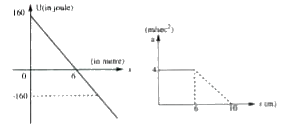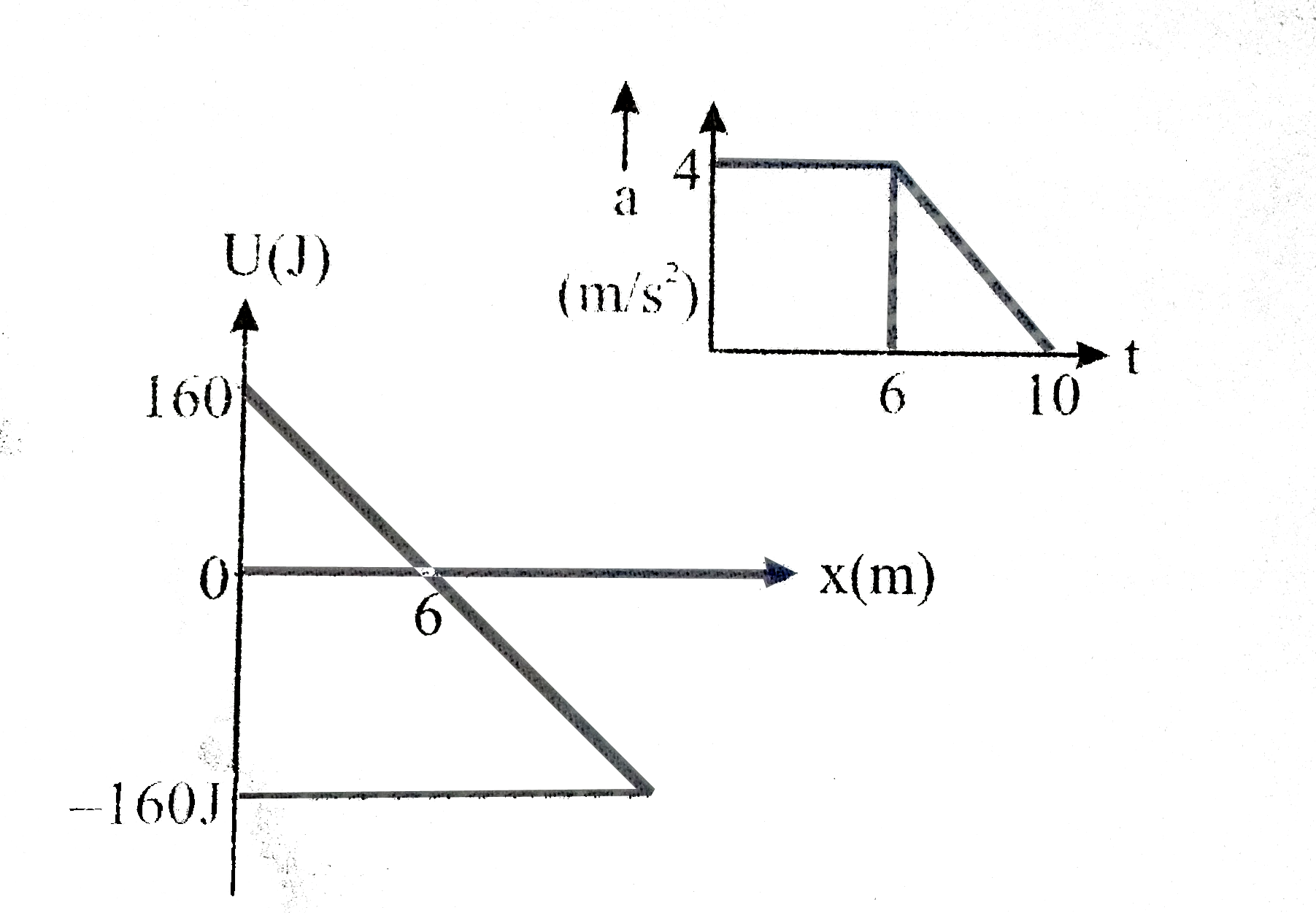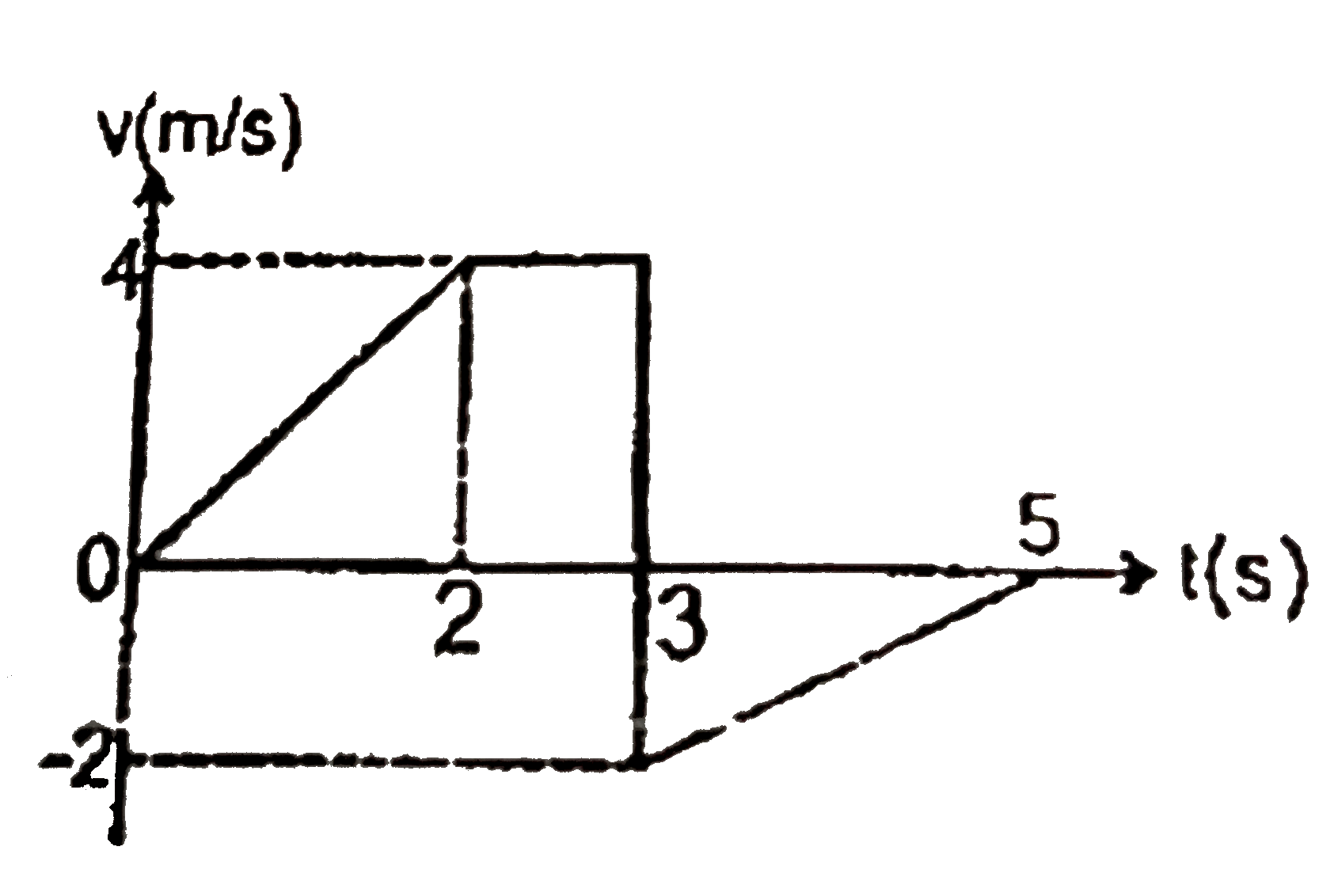A particle of mass 1 kg is moving along x-axis. It's velocity is 6m/sec at x=0. Acceleration (a), displace (x) curve and potential energy (u) -displacement (x) curve of the particle are shown.

The work done by all forces is 704 J
The work done by external forces is 350 J
The work done by external foces is 384 J
The work done by conservative forces is 300 J
The correct Answer is:A, C
Topper's Solved these Questions
- WORK -POWER-ENERGYBOOK - AAKASH SERIESCHAPTER - WORK -POWER-ENERGYEXERCISE - PRACTICE SHEET (EXERCISE-IV POTENTIAL ENERGY) (LEVEL -I STRAIGHT OBJECTIVE TYPE QUESTIONS)
3 Videos
- WORK -POWER-ENERGYBOOK - AAKASH SERIESCHAPTER - WORK -POWER-ENERGYEXERCISE - PRACTICE SHEET (EXERCISE-IV POTENTIAL ENERGY) (LEVEL -II STRAIGHT OBJECTIVE TYPE QUESTIONS)
2 Videos
- WORK -POWER-ENERGYBOOK - AAKASH SERIESCHAPTER - WORK -POWER-ENERGYEXERCISE - PRACTICE SHEET (EXERCISE-III CONSERVATIVE AND NON CONSERVATIVE FORCES) (LEVEL -I STRAIGHT OBJECTIVE TYPE QUESTIONS)
3 Videos
- VISCOSITY BOOK - AAKASH SERIESCHAPTER - VISCOSITY EXERCISE - Questions for Descriptive Answers
3 Videos
- WORK POWER ENERGYBOOK - AAKASH SERIESCHAPTER - WORK POWER ENERGYEXERCISE - EXERCISE - 3
61 Videos
Similar Questions
The potential energy of a particle of mass 2kg moving along the x-axis is given by U(x)=4x2−2x3( where U is in joules and x is in meters). The kinetic energy of the particle is maximum at
View Solution(a) A particle is moving along the x axis and its velocity vs position graph is as shown. Is the acceleration of the particle increasing, decreasing or remains constant?

(b) A particle is moving along x axis and its velocity (v) vs position (x) graph is a curve as shown in the figure. Line APB is normal to the curve at point P. Find the instantaneous acceleration of the particle at x=3.0m.

View Solution
Knowledge Check
A particle of mass 1kg is moving X-axis. Its velocity is 6m/s at x=0. Acceleration-displacement curve and potential energy-dispalcement curve of the particle are shown :
 .Athe work done by all the forces is 704JBthe work done by external forces is 350JCthe work done by external forces is 384JDthe work done by conservation forces is 300J.
.Athe work done by all the forces is 704JBthe work done by external forces is 350JCthe work done by external forces is 384JDthe work done by conservation forces is 300J.The displacement 'x' (in meter) of a particle of mass 'm' (in kg) moving in one dimension under the action of a force is released to time 't' (in sec) by t=√x+3. The displacement of the particle when its velocity is zero will be.
A2 mB4 mCzeroD6 mA partical of mass 2kg is moving on the x−axis with a constant mechanical energy 20J. Its potential energy at any x is U=(16−x2)J where x is in metre. The minimum velocity of particle is :−
A2m/sB4m/sC6m/sDzero
A particle of unit mass is moving along x-axis. The velocity of particle varies with position x as v(x). =αx−β (where α and β are positive constants and x>0 ). The acceleration of the particle as a function of x is given as
View SolutionA particle of unit mass is moving along x-axis. The velocity of particle varies with position x as v(x). =αx−β (where α and β are positive constants and x>0 ). The acceleration of the particle as a function of x is given as
View SolutionFor a particle moving along x-axis, velocity-time graph is as shown in figure. Find the displacement of the particle?

View SolutionThe displacement 'x' (in meter) of a particle of mass 'm' (in kg) moving in one dimension under the action of a force is released to time 't' (in sec) by t2=√x+2. The displacement of the particle when its velocity is zero will be.
View SolutionThe potential energy of a particle of mass 1 kg free to move along x-axis is given by U(x)=(x22−x) joule. If total mechanical energy of the particle is 2J then find the maximum speed of the particle. (Assuming only conservative force acts on particle)
View Solution
